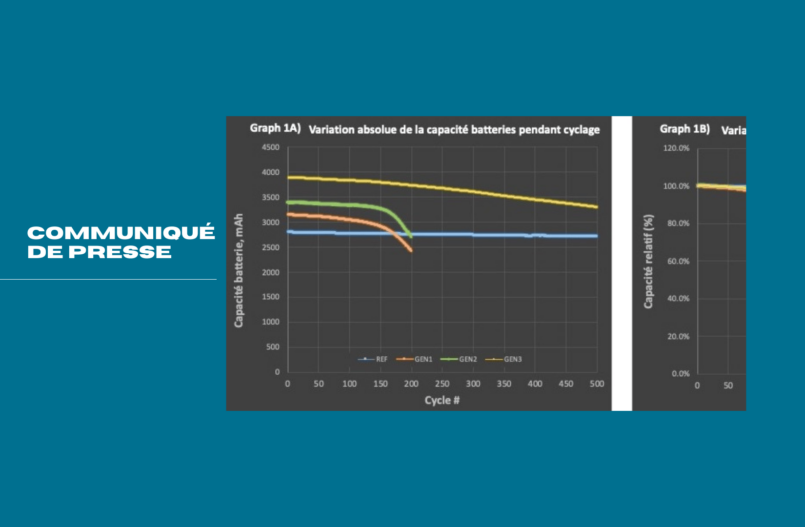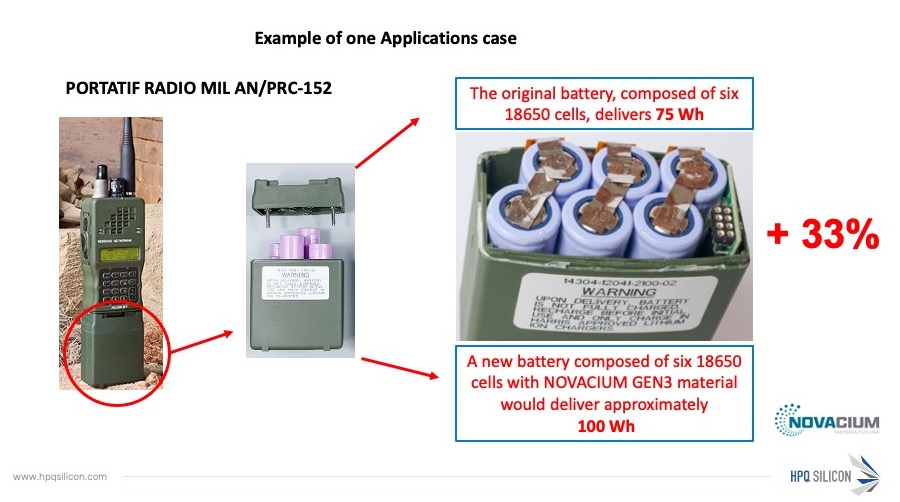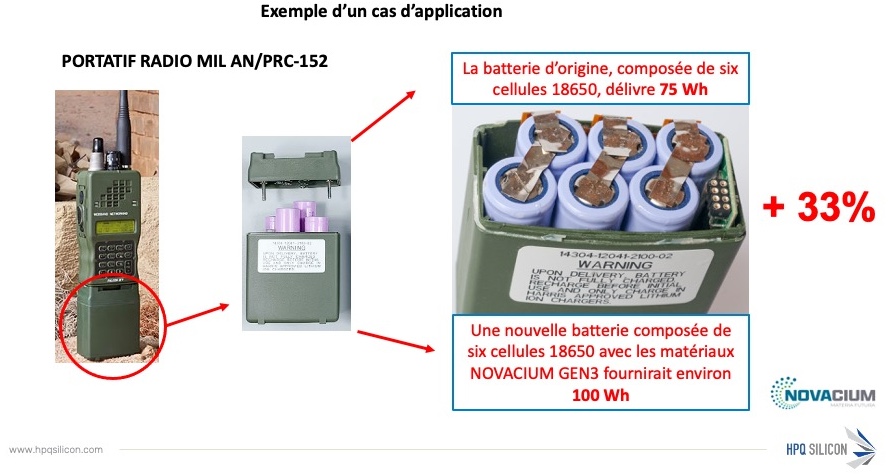MONTREAL, Canada — HPQ Silicon Inc. (“HPQ” or the “Company”) (TSX-V: HPQ) (OTCQB: HPQFF) (FRA: O08), a technology company specializing in green engineering of silica and silicon-based materials, is pleased to update shareholders on the latest battery milestones achieved by its France-based affiliate, NOVACIUM SAS (Novacium).
After 500 cycles of rigorous testing protocols [5] (0.5C cycling at 25°C), the Lithium-ion 18650 batteries made with a blend of graphite and Novacium’s GEN3 silicon-based anode material showed unmatched capacity and durability, achieving a 22% capacity improvement compared to graphite benchmarks with 85% capacity retention. Furthermore, analysis suggests that minor process modifications could reduce degradation to below 10% after 500 cycles.
“These outstanding results represent a major technical milestone, demonstrating our technology’s potential to significantly enhance energy density and extend lithium-ion battery lifespan without costly retooling or overhauls of existing manufacturing processes,” said Dr. Jed Kraiem, COO of Novacium. “Our projection models continue to indicate that by the 1,000-cycle mark, GEN3 material performance should match the projected graphite benchmark at that stage [6].”
PUSHING BATTERY PERFORMANCE AND COULOMBIC EFFICIENCY WITH SILICON-BASED ANODES AT 500 CYCLES
Graph 1A highlights the superior capacity (in mAh) of 18650 batteries made with Novacium’s GEN3 material (yellow line) compared to the 100% graphite benchmark (blue line) over 500 cycles. Batteries utilizing GEN2 (green line) and GEN1 (orange line) materials, on the other hand, fail to maintain performance beyond the 200-cycle mark. At 500 cycles, the data shows that GEN3 batteries sustain an average capacity of 3,301 mAh, significantly outperforming the graphite benchmark’s 2,708 mAh.
Graph 1B provides a closer look at the performance degradation (or Coulombic efficiency [7]) of the GEN3 silicon material over 500 cycles, showing a capacity retention of 85% compared to the graphite benchmark’s 97%—a 12% difference. Specifically, after 500 cycles, the absolute capacity of GEN3 batteries (yellow line) decreased from 3,883 mAh to 3,301 mAh, while the graphite benchmark (blue line) exhibited a slight reduction from 2,780 mAh to 2,708 mAh.
The data in Graph 1B reveals that between the 300 and 500-cycle mark, batteries made with Novacium’s GEN3 material showed a 7.9% drop (from 93.0% to 85.1%) compared to the graphite benchmark 1.1% capacity degradation (from 98.0% to 96.9%).
“I am thrilled by the capacity and durability shown in our results so far, and the path we’ve identified to further improve them,” added Dr. Kraiem. “This truly confirms the value of the battery expertise we’ve developed and the silicon anode research we’ve conducted over the past year.”
GEN3 SILICON-BASED MATERIALS OFFER REAL-WORLD SOLUTIONS FOR ENHANCED PERFORMANCE
Representatives from a NATO member country have approached Novacium to explore whether our GEN3 silicon-based anode materials could enhance the operational capacity of their SYNAPS-H tactical radio’s battery pack.
As demonstrated in the image below, replacing the six 18650 cells currently used in their tactical radios with six 18650 cells with Novacium’s GEN3 silicon-based anode materials would boost available energy by 33%, increasing the watt-hours (Wh) from 75 Wh to 100 Wh.
“Our battery material has the potential to offer real-world solutions to market participants, and this is the catalyst for the growing interest we are receiving from various industries,” said Bernard Tourillon, President and CEO of HPQ Silicon Inc. and NOVACIUM SAS. “As we advance in developing proprietary processes, HPQ will be positioned to manufacture silicon-based anode materials with low operating and capital costs and a minimal carbon footprint, solidifying HPQ and NOVACIUM as key players in delivering next-generation energy solutions that meet the industry’s performance and sustainability goals.”
REFERENCE SOURCES
[1] Management’s opinion is based on a review of capacity and durability data from commercially available 18650 batteries manufactured by Murata, Panasonic: NCR18650G-datasheet-specifications and Samsung INR18650-35E Battery.
[2] Novacium technical team analysis of the data from the ongoing charging and discharging cycle tests conducted at a world-leading university, the name of which is kept confidential for competitive reasons.
[3] Link to the source of the information on MuRata Manufacturing high-performance US18650VTC6.
[4] To maintain confidentiality for competitive industry reasons, the identities of the parties involved in the NDAs will remain undisclosed.
[5] Cycling parameters from: Ratnakumar Bugga et al. “Performance of Commercial High Energy and High Power Li-Ion Cells in Jovian Missions Encountering High Radiation Environments”, NASA Battery Workshop November 19-21, 2019.,
[6] Novacium’s technical team has used data from the ongoing charge-discharge cycle tests to build a model projecting future battery performance up to 1,000 cycles. These projections will be updated as new cycling results are received.
[7] Link to information on what is Coulombic efficiency.



